11 minutes
Trình khám phá Graph
Unlock the world of Subgraphs and network data with Graph Explorer.
Tổng quan
Graph Explorer consists of multiple parts where you can interact with Subgraphs, delegate, engage participants, view network information, and access your user profile.
Inside Explorer
The following is a breakdown of all the key features of Graph Explorer. For additional support, you can watch the Graph Explorer video guide.
Subgraphs Page
After deploying and publishing your Subgraph in Subgraph Studio, go to Graph Explorer and click on the “Subgraphs” link in the navigation bar to access the following:
- Your own finished Subgraphs
- Subgraphs published by others
- The exact Subgraph you want (based on the date created, signal amount, or name).
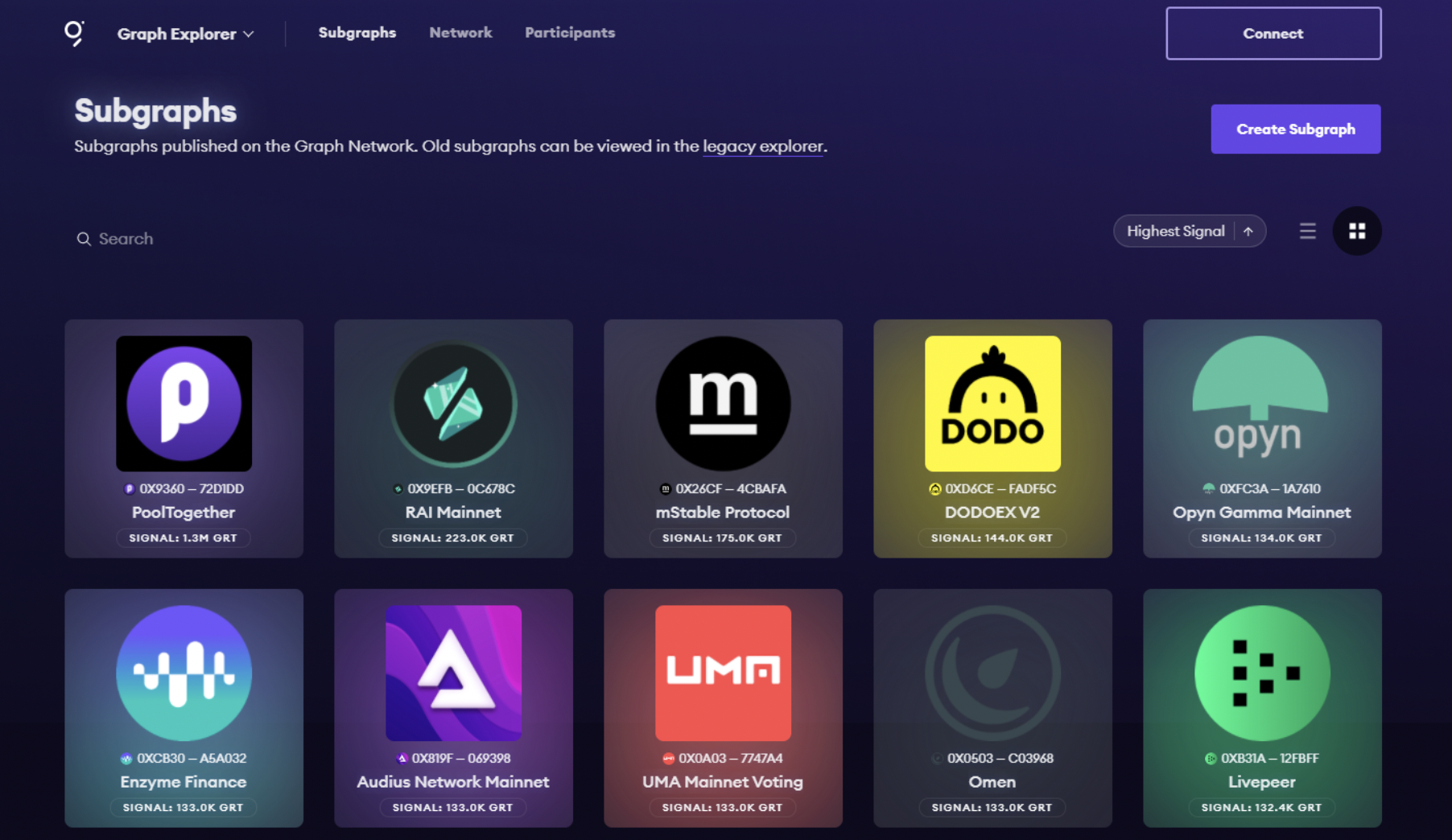
When you click into a Subgraph, you will be able to do the following:
- Test queries in the playground and be able to leverage network details to make informed decisions.
- Signal GRT on your own Subgraph or the Subgraphs of others to make indexers aware of its importance and quality.
- This is critical because signaling on a Subgraph incentivizes it to be indexed, meaning it’ll eventually surface on the network to serve queries.
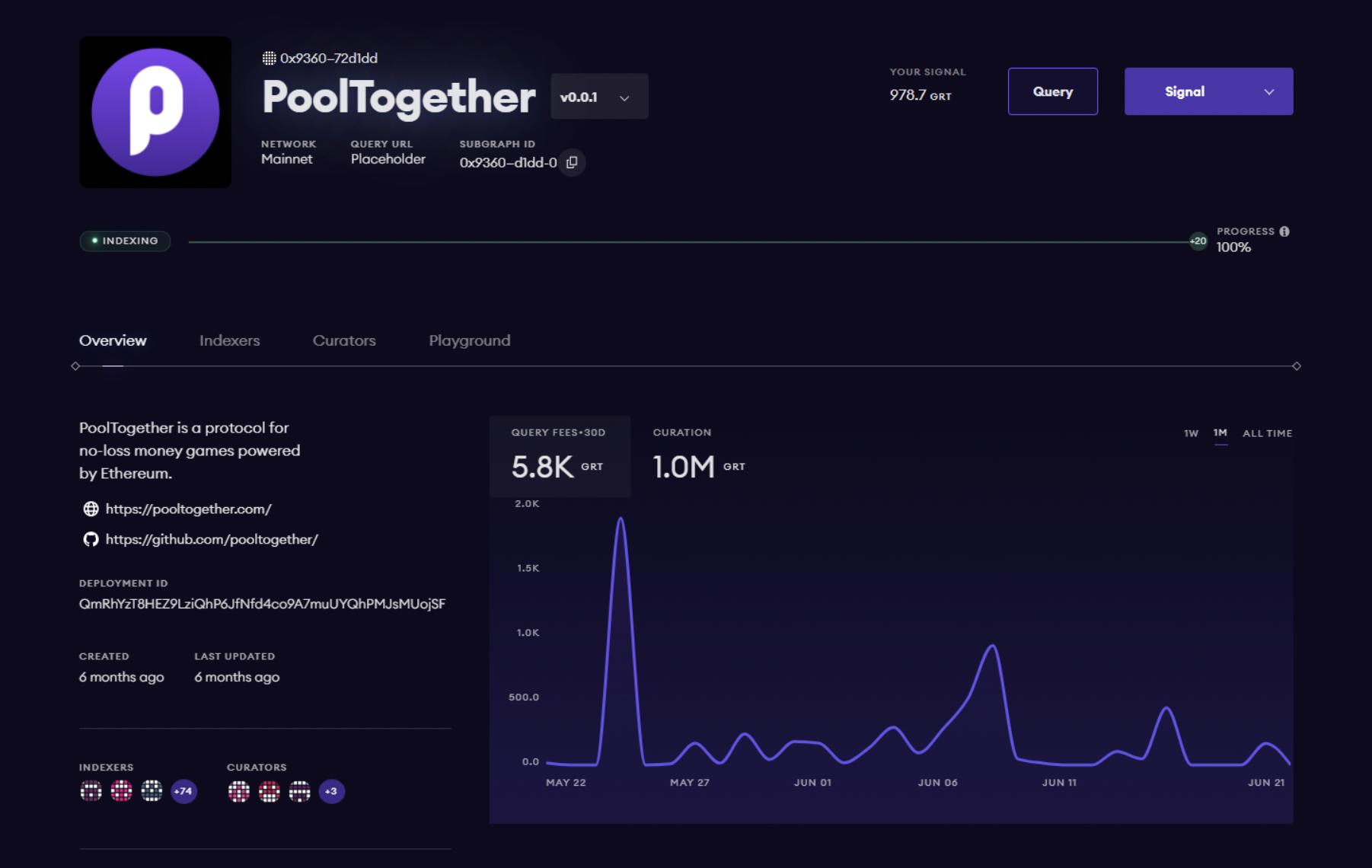
On each Subgraph’s dedicated page, you can do the following:
- Signal/Un-signal on Subgraphs
- Xem thêm chi tiết như biểu đồ, ID triển khai hiện tại và siêu dữ liệu khác
- Switch versions to explore past iterations of the Subgraph
- Query Subgraphs via GraphQL
- Test Subgraphs in the playground
- View the Indexers that are indexing on a certain Subgraph
- Thống kê Subgraph (phân bổ, Curators, v.v.)
- View the entity who published the Subgraph
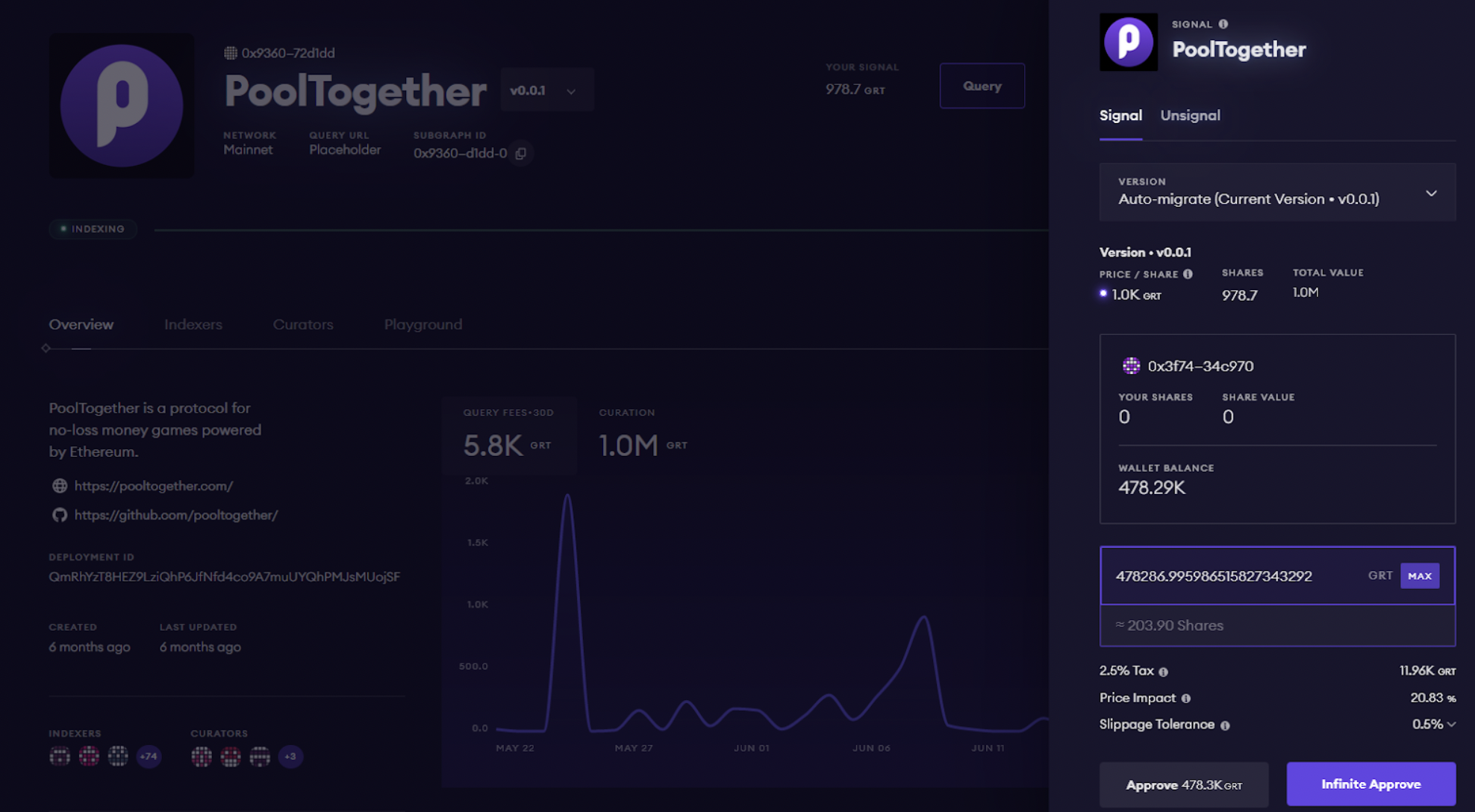
Delegate Page
On the Delegate page, you can find information about delegating, acquiring GRT, and choosing an Indexer.
On this page, you can see the following:
- Indexers who collected the most query fees
- Indexers with the highest estimated APR
Additionally, you can calculate your ROI and search for top Indexers by name, address, or Subgraph.
Participants Page
This page provides a bird’s-eye view of all “participants,” which includes everyone participating in the network, such as Indexers, Delegators, and Curators.
1. Indexers
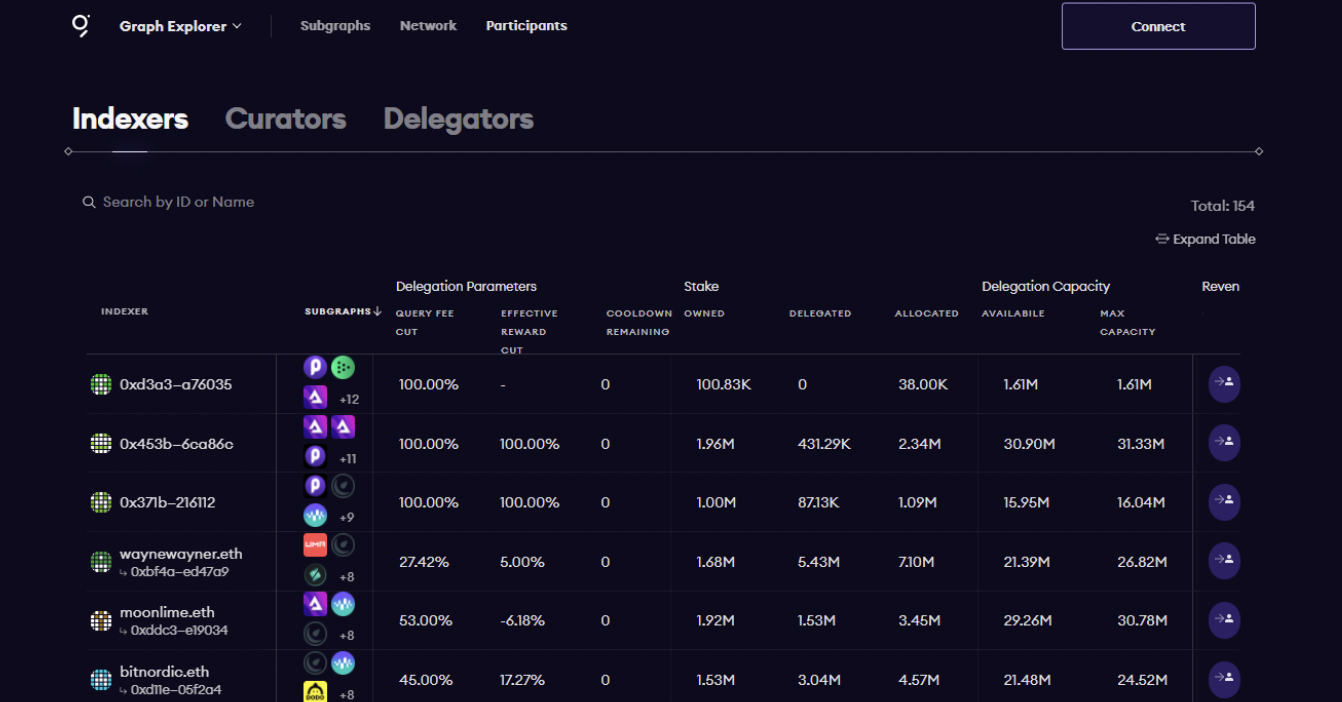
Indexers are the backbone of the protocol. They stake on Subgraphs, index them, and serve queries to anyone consuming Subgraphs.
In the Indexers table, you can see an Indexers’ delegation parameters, their stake, how much they have staked to each Subgraph, and how much revenue they have made from query fees and indexing rewards.
Specifics
- Query Fee Cut - the % of the query fee rebates that the Indexer keeps when splitting with Delegators.
- Effective Reward Cut - the indexing reward cut applied to the delegation pool. If it’s negative, it means that the Indexer is giving away part of their rewards. If it’s positive, it means that the Indexer is keeping some of their rewards.
- Cooldown Remaining - the time remaining until the Indexer can change the above delegation parameters. Cooldown periods are set up by Indexers when they update their delegation parameters.
- Owned - This is the Indexer’s deposited stake, which may be slashed for malicious or incorrect behavior.
- Delegated - Stake from Delegators which can be allocated by the Indexer, but cannot be slashed.
- Allocated - Stake that Indexers are actively allocating towards the Subgraphs they are indexing.
- Available Delegation Capacity - the amount of delegated stake the Indexers can still receive before they become over-delegated.
- Max Delegation Capacity - the maximum amount of delegated stake the Indexer can productively accept. An excess delegated stake cannot be used for allocations or rewards calculations.
- Query Fees - this is the total fees that end users have paid for queries from an Indexer over all time.
- Thưởng Indexer - đây là tổng phần thưởng indexer mà Indexer và các Delegator của họ kiếm được cho đến hiện tại. Phần thưởng Indexer được trả thông qua việc phát hành GRT.
Indexers can earn both query fees and indexing rewards. Functionally, this happens when network participants delegate GRT to an Indexer. This enables Indexers to receive query fees and rewards depending on their Indexer parameters.
- Indexing parameters can be set by clicking on the right-hand side of the table or by going into an Indexer’s profile and clicking the “Delegate” button.
To learn more about how to become an Indexer, you can take a look at the official documentation or The Graph Academy Indexer guides.
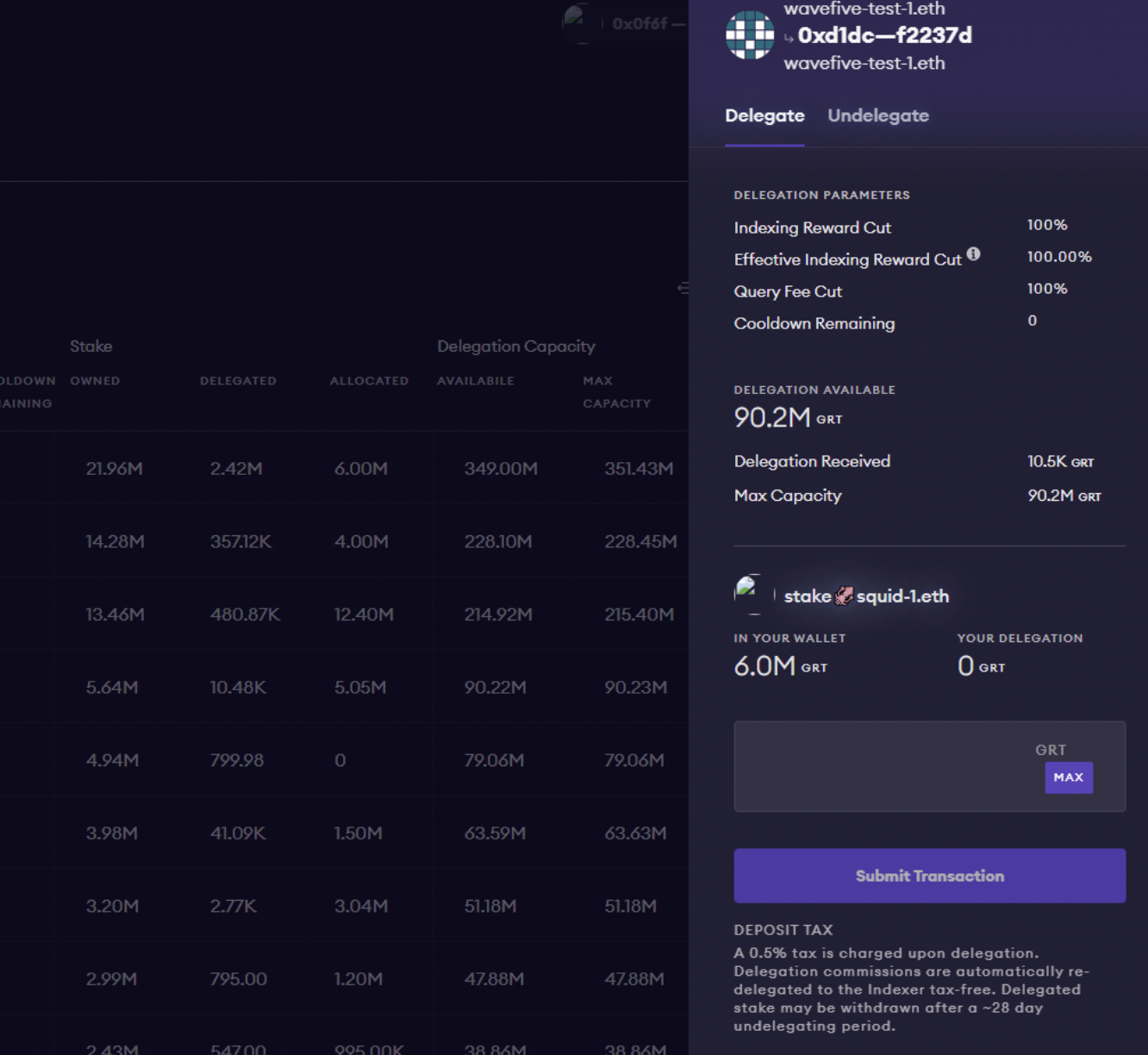
2. Curators
Curators analyze Subgraphs to identify which Subgraphs are of the highest quality. Once a Curator has found a potentially high-quality Subgraph, they can curate it by signaling on its bonding curve. In doing so, Curators let Indexers know which Subgraphs are high quality and should be indexed.
- Curators can be community members, data consumers, or even Subgraph developers who signal on their own Subgraphs by depositing GRT tokens into a bonding curve.
- By depositing GRT, Curators mint curation shares of a Subgraph. As a result, they can earn a portion of the query fees generated by the Subgraph they have signaled on.
- The bonding curve incentivizes Curators to curate the highest quality data sources.
In the The Curator table listed below you can see:
- Ngày Curator bắt đầu curate
- Số GRT đã được nạp
- Số cổ phần một Curator sở hữu
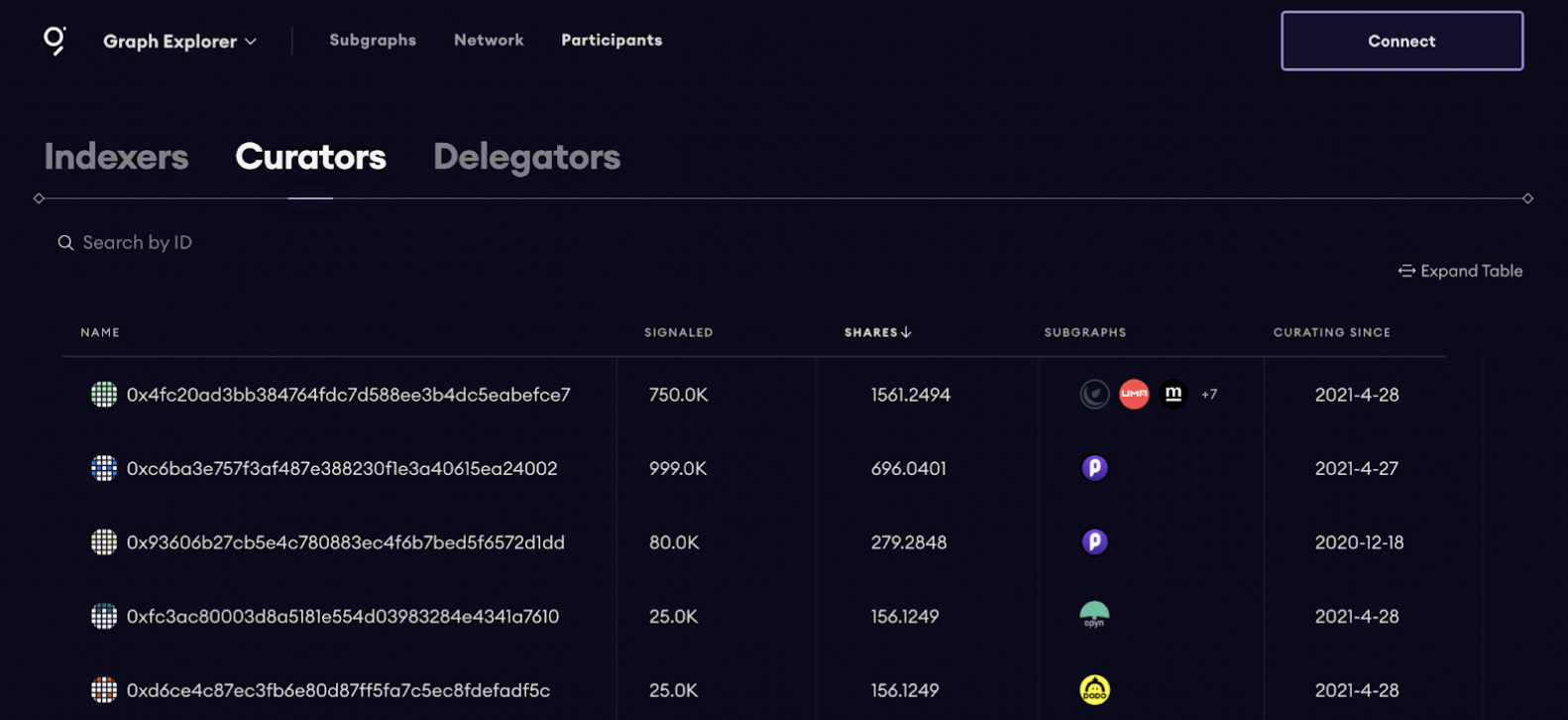
If you want to learn more about the Curator role, you can do so by visiting official documentation. or The Graph Academy.
3. Delegators
Delegators play a key role in maintaining the security and decentralization of The Graph Network. They participate in the network by delegating (i.e., “staking”) GRT tokens to one or multiple indexers.
- Without Delegators, Indexers are less likely to earn significant rewards and fees. Therefore, Indexers attract Delegators by offering them a portion of their indexing rewards and query fees.
- Delegators select Indexers based on a number of different variables, such as past performance, indexing reward rates, and query fee cuts.
- Reputation within the community can also play a factor in the selection process. It’s recommended to connect with the selected Indexers via The Graph’s Discord or The Graph Forum.
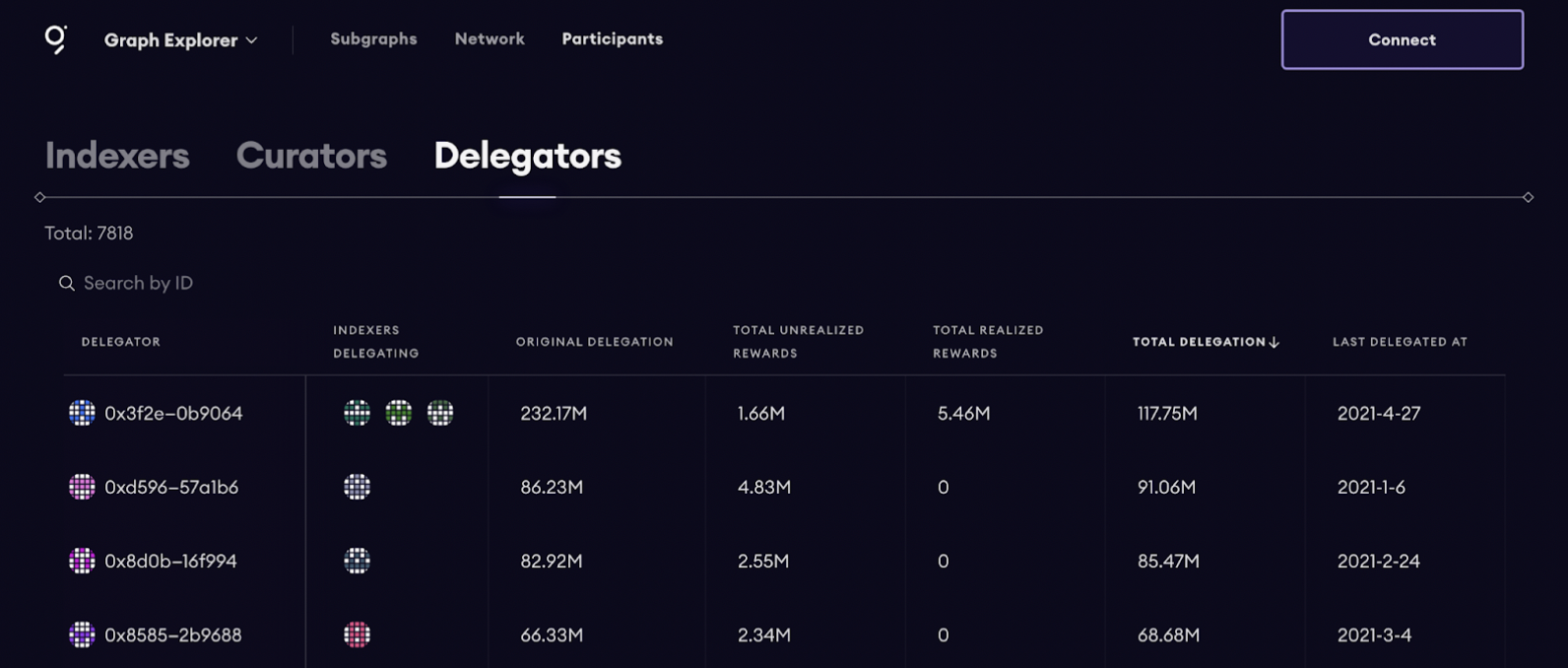
In the Delegators table you can see the active Delegators in the community and important metrics:
- Số lượng Indexers mà một Delegator đang ủy quyền cho
- A Delegator’s original delegation
- Phần thưởng họ đã tích lũy nhưng chưa rút khỏi giao thức
- Phần thưởng đã ghi nhận ra mà họ rút khỏi giao thức
- Tổng lượng GRT mà họ hiện có trong giao thức
- The date they last delegated
If you want to learn more about how to become a Delegator, check out the official documentation or The Graph Academy.
Network Page
On this page, you can see global KPIs and have the ability to switch to a per-epoch basis and analyze network metrics in more detail. These details will give you a sense of how the network is performing over time.
Tổng quan
The overview section has both all the current network metrics and some cumulative metrics over time:
- Tổng stake mạng hiện tại
- Phần chia stake giữa Indexer và các Delegator của họ
- Tổng cung GRT, lượng được đúc và đốt kể từ khi mạng lưới thành lập
- Tổng phần thưởng Indexing kể từ khi bắt đầu giao thức
- Các thông số giao thức như phần thưởng curation, tỷ lệ lạm phát,…
- Phần thưởng và phí của epoch hiện tại
A few key details to note:
- Query fees represent the fees generated by the consumers. They can be claimed (or not) by the Indexers after a period of at least 7 epochs (see below) after their allocations towards the Subgraphs have been closed and the data they served has been validated by the consumers.
- Indexing rewards represent the amount of rewards the Indexers claimed from the network issuance during the epoch. Although the protocol issuance is fixed, the rewards only get minted once Indexers close their allocations towards the Subgraphs they’ve been indexing. So, the per-epoch number of rewards varies (ie. during some epochs, Indexers might’ve collectively closed allocations that have been open for many days).
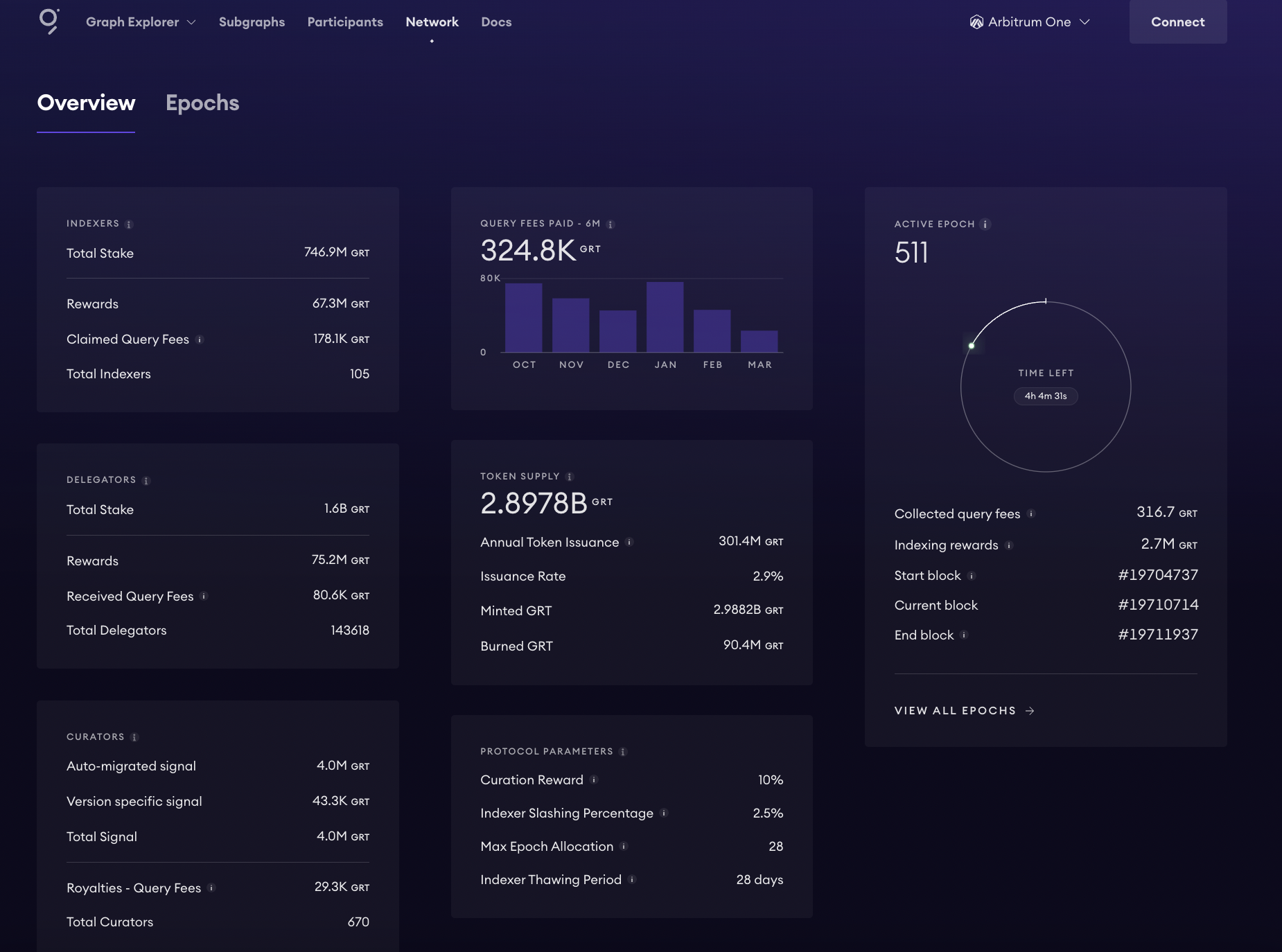
Epochs
In the Epochs section, you can analyze on a per-epoch basis, metrics such as:
- Khối bắt đầu hoặc kết thúc của Epoch
- Phí truy vấn được tạo và phần thưởng indexing được thu thập trong một epoch cụ thể
- Trạng thái Epoch, đề cập đến việc thu và phân phối phí truy vấn và có thể có các trạng thái khác nhau:
- Epoch đang hoạt động là epoch mà Indexer hiện đang phân bổ cổ phần và thu phí truy vấn
- Epoch đang giải quyết là những epoch mà các kênh trạng thái đang được giải quyết. Điều này có nghĩa là Indexers có thể bị phạt cắt giảm nếu người tiêu dùng công khai tranh chấp chống lại họ.
- Epoch đang phân phối là epoch trong đó các kênh trạng thái cho các epoch đang được giải quyết và Indexer có thể yêu cầu hoàn phí truy vấn của họ.
- The finalized epochs are the epochs that have no query fee rebates left to claim by the Indexers.
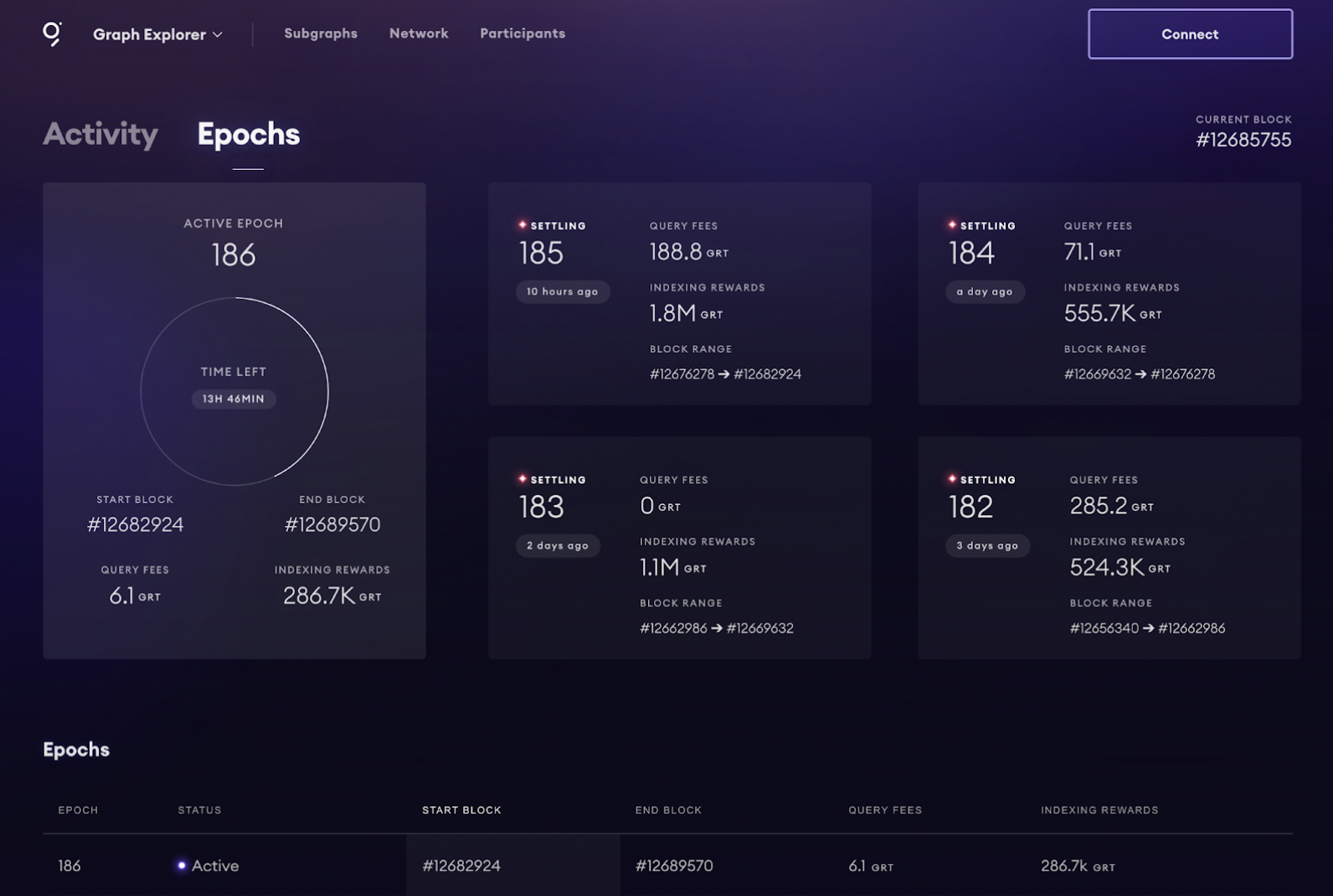
Hồ sơ Người dùng của bạn
Your personal profile is the place where you can see your network activity, regardless of your role on the network. Your crypto wallet will act as your user profile, and with the User Dashboard, you’ll be able to see the following tabs:
Tổng quan Hồ sơ
In this section, you can view the following:
- Any of your current actions you’ve done.
- Your profile information, description, and website (if you added one).
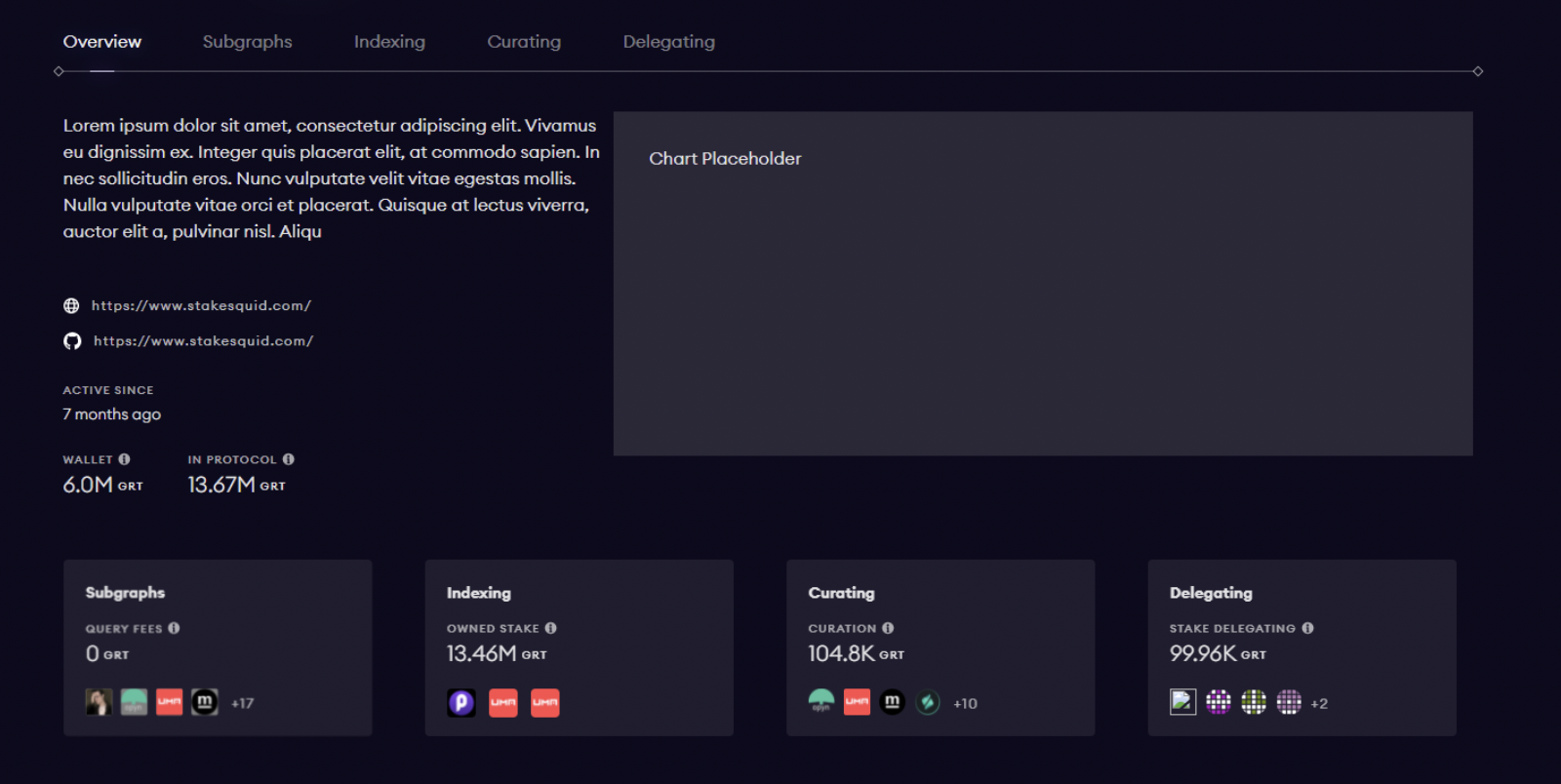
Tab Subgraphs
In the Subgraphs tab, you’ll see your published Subgraphs.
This will not include any Subgraphs deployed with the CLI for testing purposes. Subgraphs will only show up when they are published to the decentralized network.
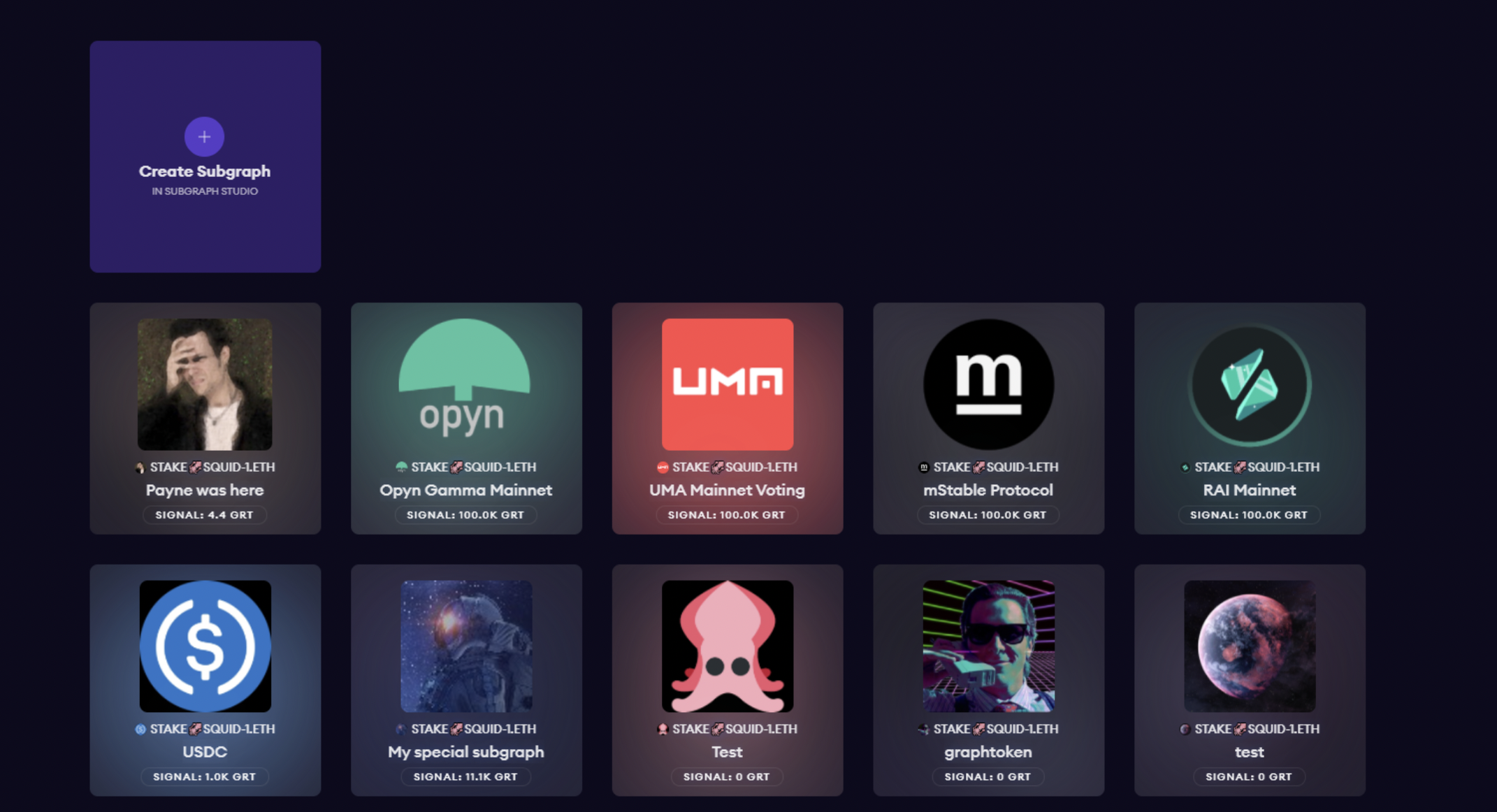
Tab Indexing
In the Indexing tab, you’ll find a table with all the active and historical allocations towards Subgraphs. You will also find charts where you can see and analyze your past performance as an Indexer.
Phần này cũng sẽ bao gồm thông tin chi tiết về phần thưởng Indexer ròng của bạn và phí truy vấn ròng. Bạn sẽ thấy các số liệu sau:
- Stake được ủy quyền - phần stake từ Delegator có thể được bạn phân bổ nhưng không thể bị phạt cắt giảm (slashed)
- Total Query Fees - the total fees that users have paid for queries served by you over time
- Phần thưởng Indexer - tổng số phần thưởng Indexer bạn đã nhận được, tính bằng GRT
- Phần Cắt Phí - lượng % hoàn phí phí truy vấn mà bạn sẽ giữ lại khi ăn chia với Delegator
- Phần Cắt Thưởng - lượng % phần thưởng Indexer mà bạn sẽ giữ lại khi ăn chia với Delegator
- Được sở hữu - số stake đã nạp của bạn, có thể bị phạt cắt giảm (slashed) vì hành vi độc hại hoặc không chính xác
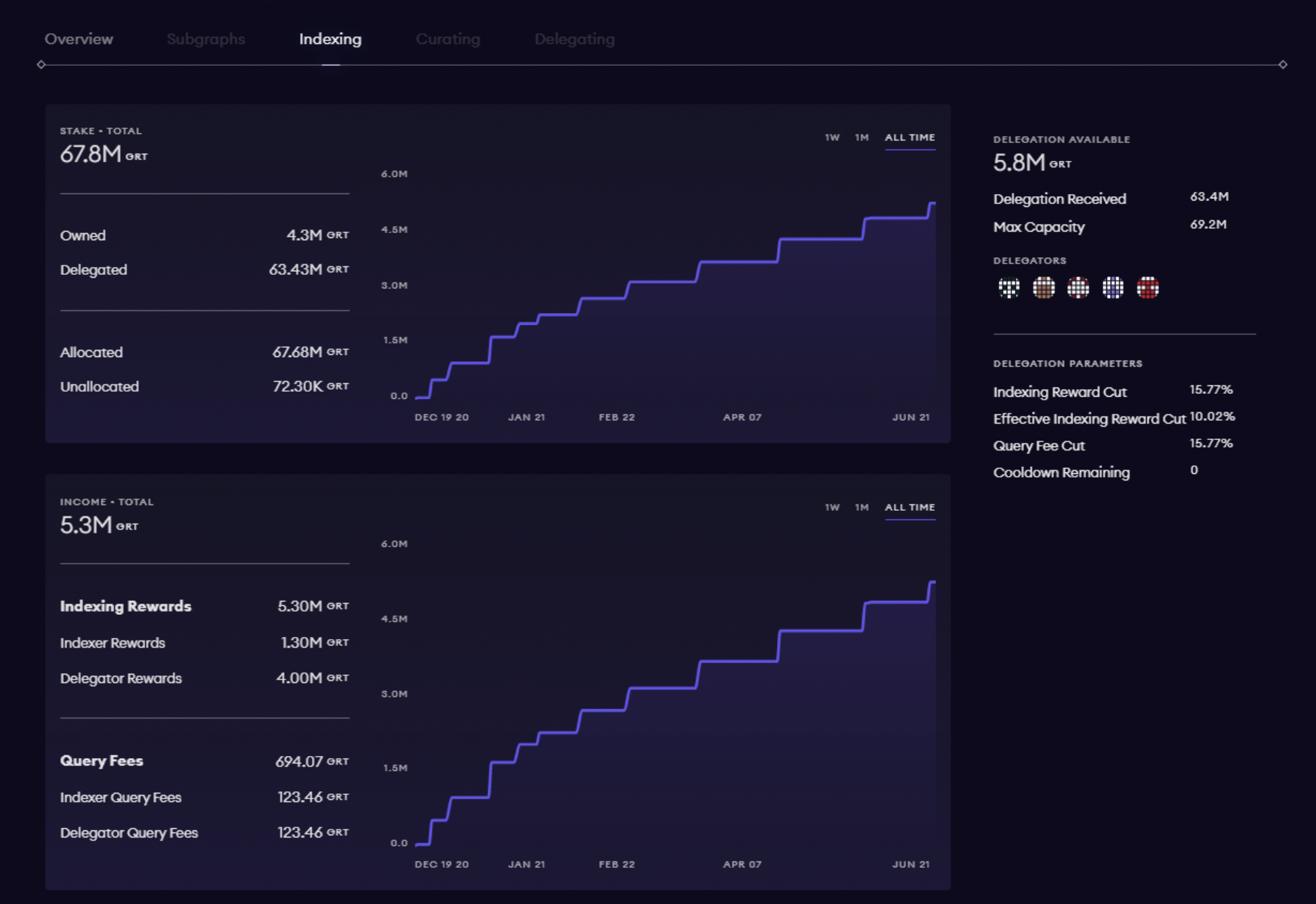
Tab Delegating
Delegators are important to the Graph Network. They must use their knowledge to choose an Indexer that will provide a healthy return on rewards.
In the Delegators tab, you can find the details of your active and historical delegations, along with the metrics of the Indexers that you delegated towards.
Trong nửa đầu của trang, bạn có thể thấy biểu đồ ủy quyền của mình, cũng như biểu đồ chỉ có phần thưởng. Ở bên trái, bạn có thể thấy các KPI phản ánh các chỉ số ủy quyền hiện tại của bạn.
Các chỉ số Delegator mà bạn sẽ thấy ở đây trong tab này bao gồm:
- Total delegation rewards
- Tổng số phần thưởng chưa ghi nhận
- Tổng số phần thưởng đã ghi được
Trong nửa sau của trang, bạn có bảng ủy quyền. Tại đây, bạn có thể thấy các Indexer mà bạn đã ủy quyền, cũng như thông tin chi tiết của chúng (chẳng hạn như phần cắt thưởng, thời gian chờ, v.v.).
Với các nút ở bên phải của bảng, bạn có thể quản lý ủy quyền của mình - ủy quyền nhiều hơn, hủy bỏ hoặc rút lại ủy quyền của bạn sau khoảng thời gian rã đông (thawing period).
Lưu ý rằng biểu đồ này có thể cuộn theo chiều ngang, vì vậy nếu bạn cuộn hết cỡ sang bên phải, bạn cũng có thể thấy trạng thái ủy quyền của mình (ủy quyền, hủy ủy quyền, có thể rút lại).
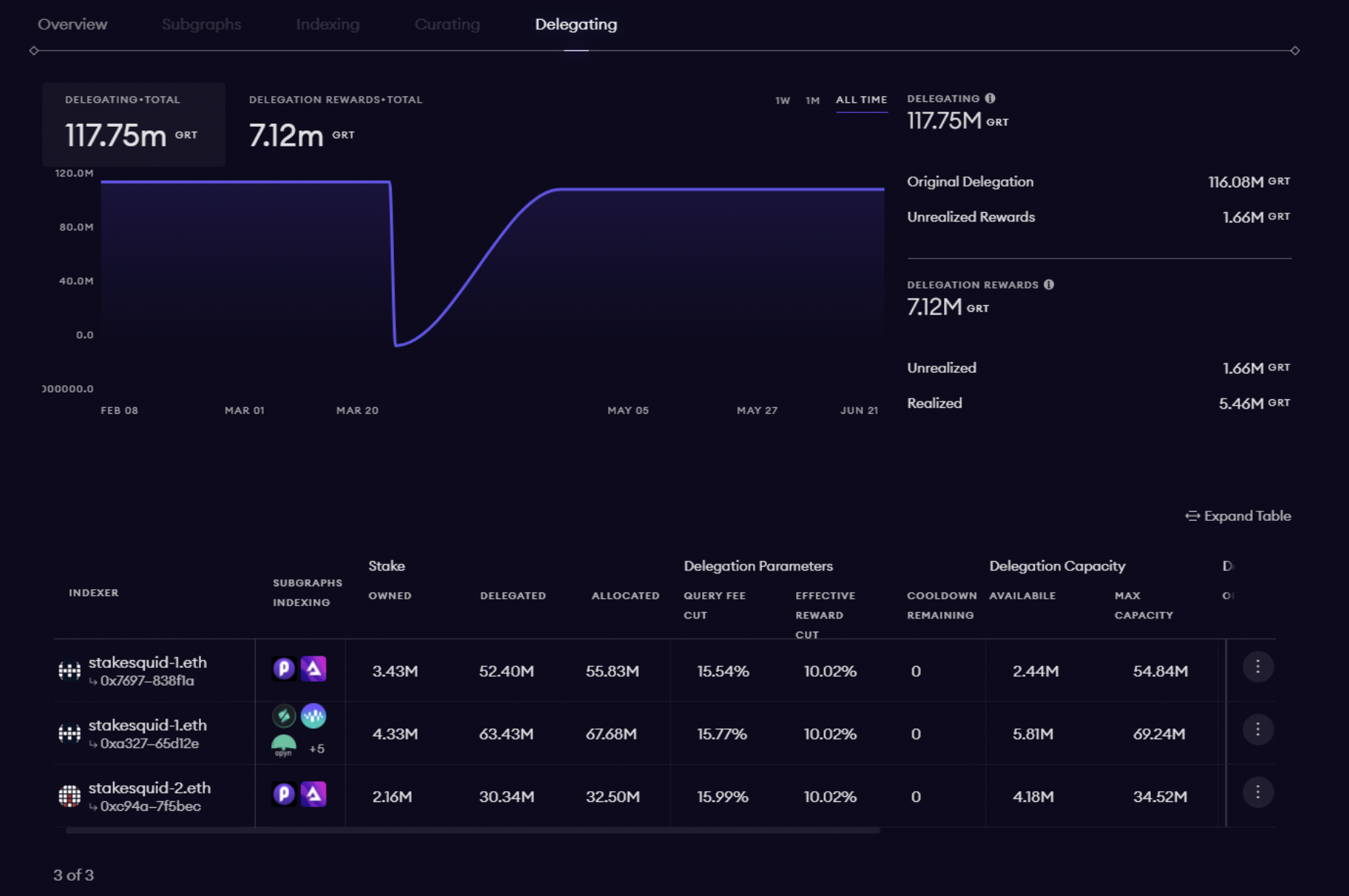
Tab Curating
In the Curation tab, you’ll find all the Subgraphs you’re signaling on (thus enabling you to receive query fees). Signaling allows Curators to highlight to Indexers which Subgraphs are valuable and trustworthy, thus signaling that they need to be indexed on.
Trong tab này, bạn sẽ tìm thấy tổng quan về:
- All the Subgraphs you’re curating on with signal details
- Share totals per Subgraph
- Query rewards per Subgraph
- Chi tiết ngày được cập nhật
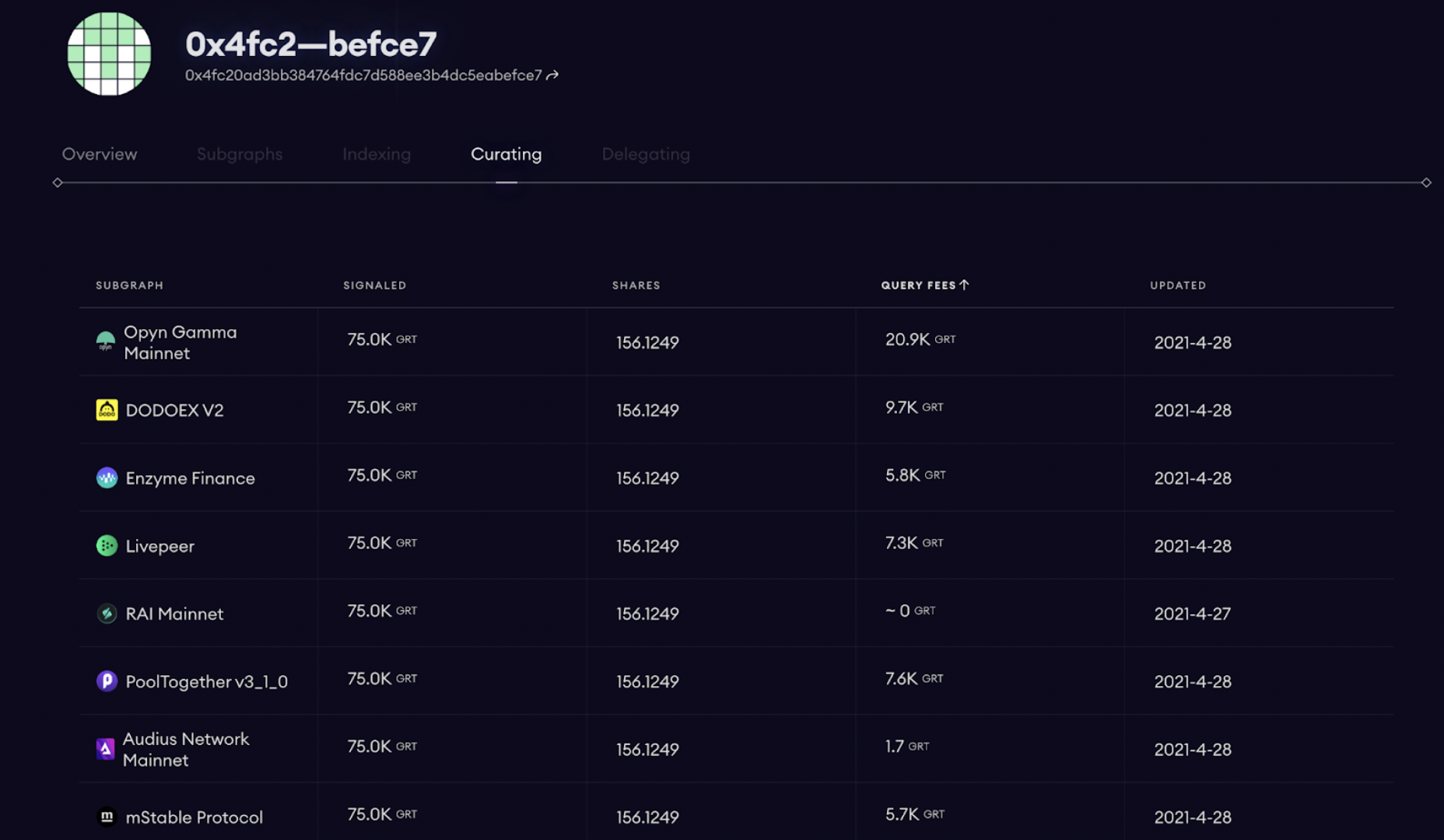
Cài đặt Hồ sơ của bạn
Trong hồ sơ người dùng của mình, bạn sẽ có thể quản lý chi tiết hồ sơ cá nhân của mình (như thiết lập tên ENS). Nếu bạn là Indexer, bạn thậm chí có nhiều quyền truy cập hơn vào các cài đặt trong tầm tay của mình. Trong hồ sơ người dùng của mình, bạn sẽ có thể thiết lập các tham số ủy quyền và operator của mình.
- Operators (Người vận hành) thực hiện các hành động được hạn chế trong giao thức thay mặt cho Indexer, chẳng hạn như mở và đóng phân bổ. Operators thường là các địa chỉ Ethereum khác, tách biệt với ví đặt staking của họ, với quyền truy cập được kiểm soát vào mạng mà Indexer có thể cài đặt cá nhân
- Tham số ủy quyền cho phép bạn kiểm soát việc phân phối GRT giữa bạn và các Delegator của bạn.
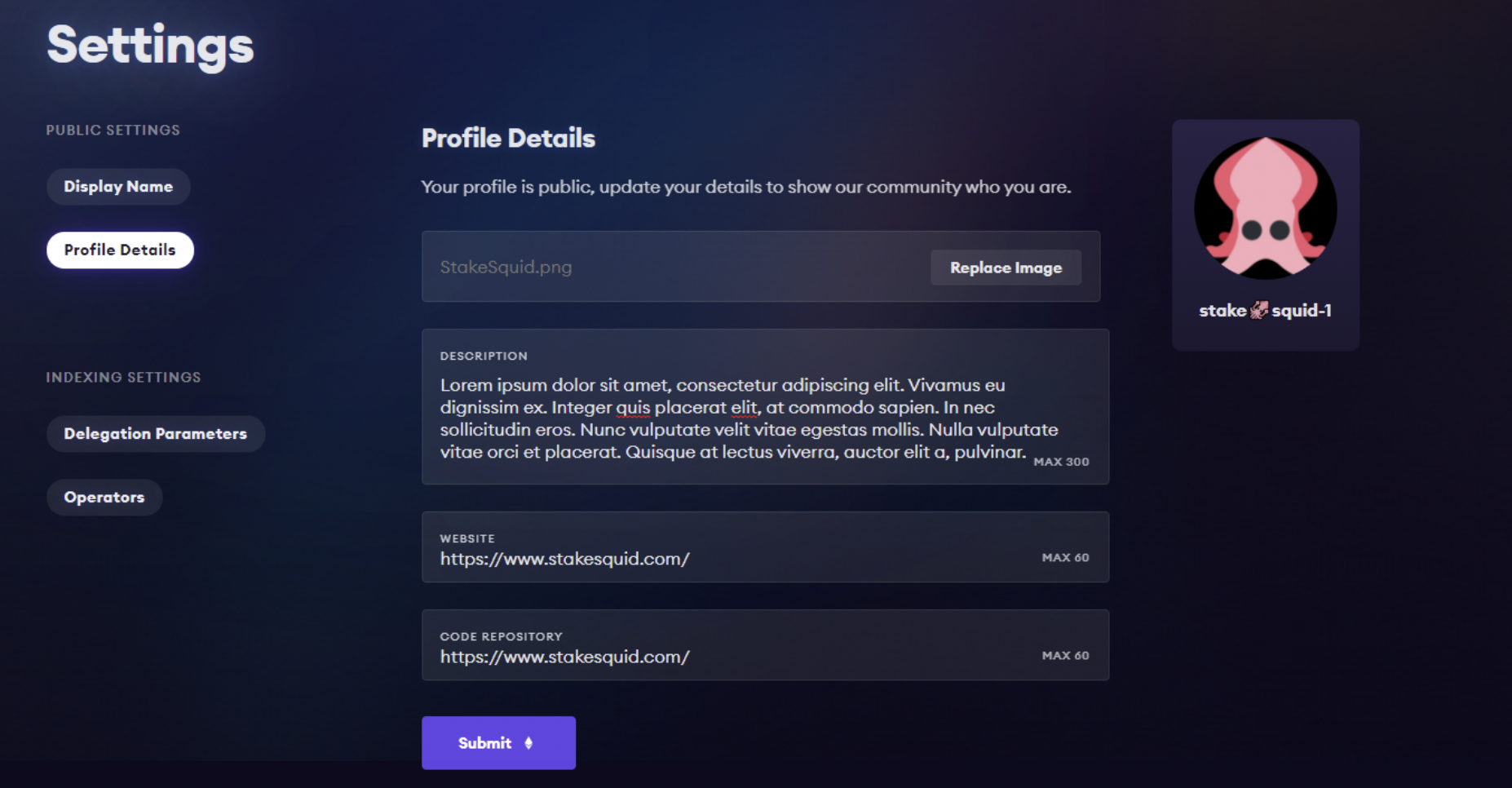
As your official portal into the world of decentralized data, Graph Explorer allows you to take a variety of actions, no matter your role in the network. You can get to your profile settings by opening the dropdown menu next to your address, then clicking on the Settings button.
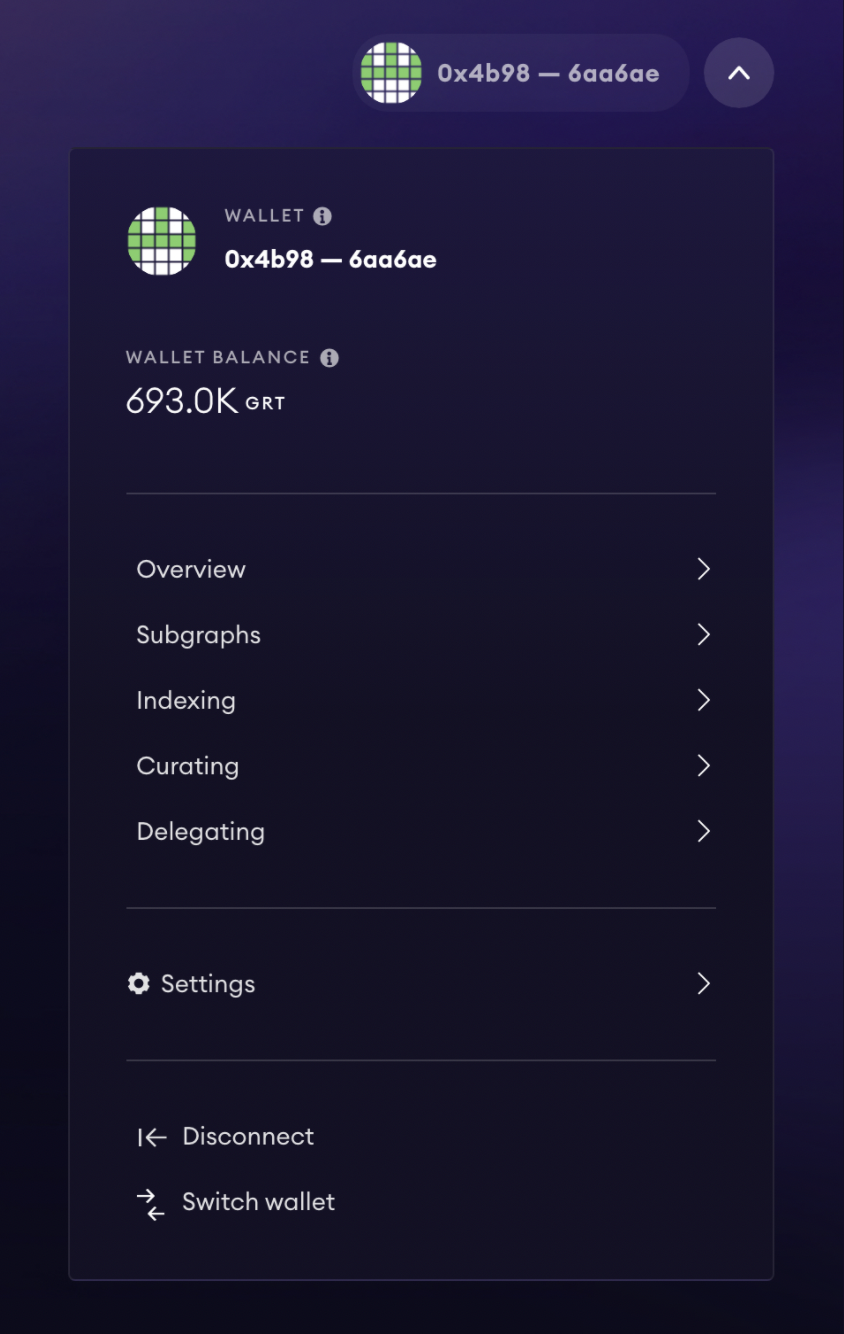
Additional Resources
Video Guide
For a general overview of Graph Explorer, check out the video below: